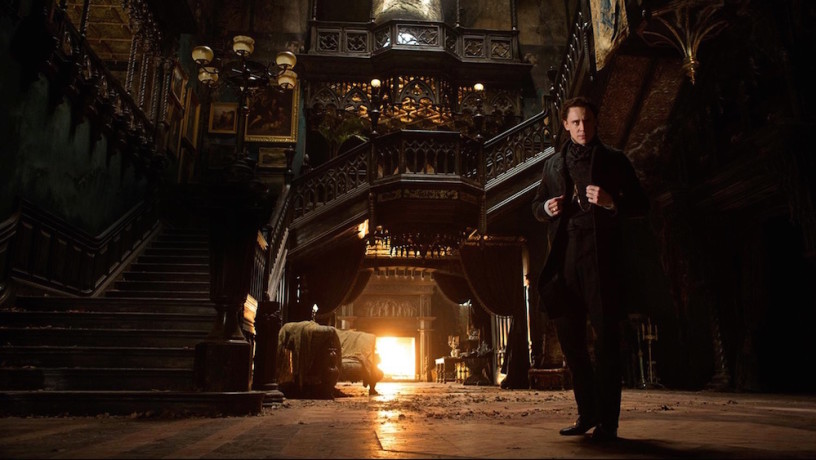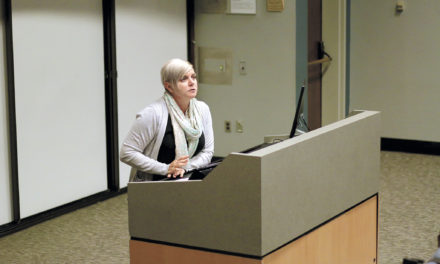From the outside, Crimson Peak is a haunted house horror film from Guillermo del Toro, a teddy bear of a man with a horror background and a penchant for fantastic monster design. Released on Oct. 16, it’s one of the few ostensibly horror films out this Halloween. A number of horror fans, or those just looking to be frightened, are going to flock to it in October, hoping for a good, high production, quality scare.
Sure, the horror neophytes (attracted by the actors or the lush design) and those with a low threshold (like, admittedly, yours truly) are going to find an oppressively creepy atmosphere and a number of startles (narratively useful jump scares, but nevertheless, jump scares). And for everyone, there’s a surprising brutality to the film’s violence. However, it’s difficult to call Crimson Peak a horror film.
That’s because at its core, it isn’t one. Crimson Peak certainly has elements of horror, and it speaks horror’s language. But for every connection the film has with Hammer or Universal Horror, the film resonates with the works of Edgar Allan Poe or Charlotte Brontë. Crimson Peak is a Gothic romance; a film about the darkness of the world and the inner workings of the heart.
After all, the film is about Edith Cushing (Mia Wasikowska), a smart, young author living in Buffalo, New York with her father. When the dashing and mysterious Sir Thomas Sharpe (Tom Hiddleston) comes to town, he sweeps her off her feet. After a family tragedy, she moves to Sharpe’s home, Allerdale Hall, a decaying old mansion where the clay underneath seeps through the walls and floors like blood. Despite the suspicions of Thomas’s sister, the cold Lucille Sharpe (Jessica Chastain), Edith is determined to make a happy life for herself. But when the ominous ghosts of the house begin to warn her that her new husband isn’t all that he seems, Edith must discover the secrets of the Sharpe family and Allerdale Hall.
If you’re telling me that doesn’t sound like a lost Edgar Allan Poe novel, or quite possibly the plot of Wuthering Heights , you’re a lying bastard.
But perhaps moreover, the film is in dialogue with previous works by Guillermo del Toro. Del Toro is a filmmaker of two languages and two different styles. There is del Toro, the Spanish-language filmmaker. In these films (Cronos, The Devil’s Backbone, Pan’s Labyrinth), he is an auteur of dark fantasy. His films are mystical and allegorical, often very personal and even political. His monsters have a great deal of personality and are incredibly well-designed, but they are often at the service of a larger purpose or ideal. Spanish-language del Toro is a weaver of fairy tales and looks into the human soul.
There is also del Toro, the English-language filmmaker. In these films (Blade II, Hellboy, Pacific Rim), he is a gleeful nerd given the keys to the toy store. These films are spectacles, welding a sense of classic genre storytelling with an eye for creature design. They often feature a great deal of confusing story decisions with less thematic resonance. However, they’re bringing infinitely more creativity to the large-scale film genre.
All of this was a long approach to say that del Toro seems to have found a way to weld the creative spectacle of his American sensibilities with the wonderful storytelling of his Spanish language films in a truly phenomenal work.
Crimson Peak is capital ‘B’ Beautiful. Every ounce of every frame is filled with brilliant period detail, excellent costuming and impossibly detailed sets that are sumptuously lit. If this film isn’t nominated for production design and costuming awards, then the Academy is a sham. Allerdale Hall is one of the best looking sets I’ve seen in some time. At one point, Thomas Sharpe tells us that the house literally breathes, and no other film set has quite lived up to that promise like Crimson Peak. Allerdale Hall does feel truly alive. The history drips from it like the red clay that seeps through its walls.
The design of the ghosts also excels. While the nuances of the ghosts’ look are best left explained by the film itself, they’re truly a disturbing sight. Skeletons bound in thin tattered red flesh, screaming as they bring themselves to life. The only lamentable aspect of their character is that they have none. After seeing del Toro’s creatures, such as the Faun (Pan’s Labyrinth) or Sammael (Hellboy), it’s a shame these ghosts have so little personality. But that’s not the point of them. They’re omens for the real monsters.
If you’re so inclined, it’s completely worth watching this film just to take in every ounce of the visual detail. A silent watching of this film would likely be almost as rewarding as one with sound.
But without sound, you would miss the strong performances of its main cast. Unsurprisingly (given the cast calibre), the Sharpe siblings are the undoubted highlights of the film. Tom Hiddleston (in a role originally cast to Benedict Cumberbatch) plays the Gothic romance hero, mysterious and smoldering. Equal parts smooth and prone to flying off the handle when necessary, Hiddleston plays Sir Thomas Sharpe as someone with whom it’s effortless to fall in love, but who makes every twist he takes feel completely organic.
And the less I can say about Jessica Chastain’s performance as Lucille Sharp, the better. Let it be simply said that she is the MVP of this film, going outside of her comfort zone to play a beautifully complex character. She clearly relishes her role, and she dances constantly on the line between over the top and just right. This film so well exemplifies the sheer control Chastain has over her performances and how effortlessly she imbues a second or third layer underneath what she’s doing. Crimson Peak has likely opened up a whole new realm in her career.
Mia Wasikowska is someone I’ve always had a hard time connecting with. This is mostly because she represents a kind of acting I’ve always been uncomfortable with: a wide-eyed cipher who acts by the Kuleshov Effect, allowing what’s around her to color who her character is. In this film, she definitely brings a narrative thrust. She’s a vision of Gothic heroine, bravely barrelling forward even with her utter terror in Allerdale Hall. She’s far more of a serviceable role, but Wasikowska’s performance as Edith Cushing is definitely what the film needs at its center. And more importantly, Edith is a character who’s given enough shades to provide perspective to the film as a whole.
Rounding out our cast, and perhaps providing the film with its one weak point, is Charlie Hunnam. An actor whom I’ve admittedly never been all that impressed by, fails to impress me here. His character, Dr. Alan McMichael, is a rather well-written and admirable one, but Hunnam fails to give too much to him. He’s handsome and vulnerable, but not really much else at all.
What ended up making all the performances workwell is the narrative surrounding them. This is a film where every piece fits together like a grand puzzle. While not original, and easy to call from about halfway through, it’s an incredibly tight and thrilling genre picture.
Even more interesting is that it is a film with a female perspective. Critic Devin Faraci (of the entertainment website Birth.Movies.Death) tweeted that if Pacific Rim, del Toro’s epic of giant monsters fighting giant robots, was a film for the director’s inner 15-year-old boy, then Crimson Peak is for his inner 15-year-old girl. Certainly, one may be confused by that, given the brutality and some of the almost fetishistic sexual moments. What he seems to mean, however, is that this is a film from the perspective of a woman. It’s women driving the narrative, and the central conflict is over a woman’s understanding of love. Crimson Peak gives women the narrative power, and this is incredibly refreshing.
Crimson Peak is a wonderful, beautiful, brutal, deeply fucked up film. It’s got more than a few tarnishes on it, but the film is just such a great thing to experience that its flaws are easy to ignore. It’s a film for the inner 15-year-old girl not just in del Toro, but in us all. It’s likely that you (thanks to confusing marketing) have no idea what this film is about, but I really do encourage you to go out and get lost at Allerdale Hall.
GRADE: A-
Opinion Editor | Brandon Wagner is a College Senior from God Only Knows Where, America studying Film and Media Studies with a minor in Religion. This is his first year for the Wheel, in a likely misguided experiment to be a film critic. When he's not writing on the biggest blockbusters or the films of Spike Jonze or Andrei Tarkovsky or Zack Snyder, he's writing on comedic television, the future of gaming as an art, or the relationship between audience and cinematic experience. In other words, Brandon Wagner has basically nothing else going on but this.







Loved the movie, too. All the actors were wonderful. The writer should watch Wasikowska’s performance as Sophie in the first season of HBO’s “In Treatment” (one of the greatest, most moving performances I’ve seen) – she has many sides to her talent, it depends on the nature of the film (whether naturalistic or melodramatic or in-between). I consider her one of the most talented actors of her generation. I thought Tom Hiddelston also did a remarkable job in this film; I found Sir Thomas to be quite tragic – a very memorable character.
Thank you for the recommendation! After seeing her in this, and especially finally seeing her in what was an active role, where I’d always felt her too passive, I was definitely looking for something else to help change my opinion of Wasikowska!
Plus, In Treatment has been sitting in my watch queue forever.
Thanks for your piece on this film.
I consider “In Treatment” one of the greatest shows EVER – each half hour episode is crafted like a one act play, yet it all forms a much greater whole. The nine episodes from the first season featuring Mia Wasikowska is for me the most outstanding – it’s basically her and the wonderful Gabriel Byrne exploring character – it’s emotional, sad, humorous, way more than I can begin to describe; it’s acting at the highest level of authenticity. A far different Wasikwoska performance that is devilishly good is her vampire sprite Ava in “Only Lovers Left Alive”, along with Tom Hiddelston once again – super fun, and she plays a totally aggressive character. The difference between those two performances is vast, but along with her period film work, like “Crimson” and “Jane Eyre”, it gives you an idea of the range of her talent.